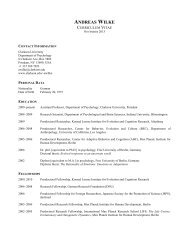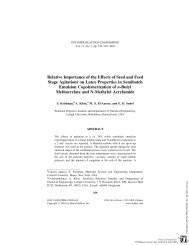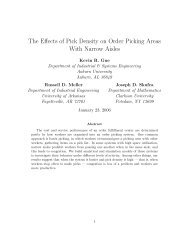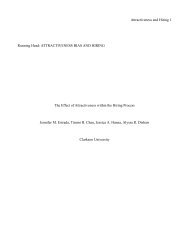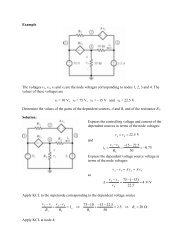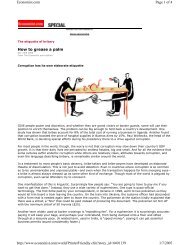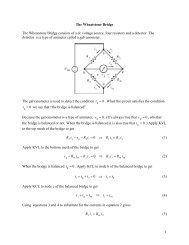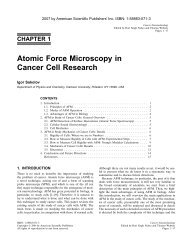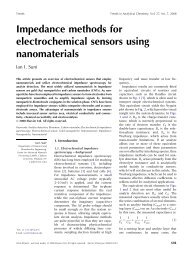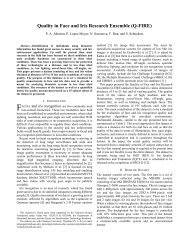Getting a Handle on Advanced Cubic Equations of State
Getting a Handle on Advanced Cubic Equations of State
Getting a Handle on Advanced Cubic Equations of State
You also want an ePaper? Increase the reach of your titles
YUMPU automatically turns print PDFs into web optimized ePapers that Google loves.
l<strong>on</strong>g as the same alpha functi<strong>on</strong> (for pure-comp<strong>on</strong>ent vapor<br />
pressure correlati<strong>on</strong>) and the same mixing rules (for mixtureproperty<br />
correlati<strong>on</strong>) are used (5). Since the ability <strong>of</strong> any<br />
CEOS to predict phase equilibria <strong>of</strong> mixtures depends <strong>on</strong> the<br />
alpha functi<strong>on</strong> and the mixing rule, these two elements will be<br />
the focus <strong>of</strong> the remainder <strong>of</strong> this article.<br />
Alpha functi<strong>on</strong>s for cubic equati<strong>on</strong>s <strong>of</strong> state<br />
The accurate predicti<strong>on</strong> <strong>of</strong> K-values from any CEOS requires<br />
an equally accurate predicti<strong>on</strong> <strong>of</strong> pure-comp<strong>on</strong>ent<br />
vapor pressures, which depends <strong>on</strong> the development <strong>of</strong> an appropriate<br />
alpha functi<strong>on</strong> α(T). The first CEOS to be successfully<br />
applied to the calculati<strong>on</strong> <strong>of</strong> thermodynamic properties<br />
for the vapor phase was the modified form <strong>of</strong> the van der<br />
Waals equati<strong>on</strong> by Redlich and Kw<strong>on</strong>g (6), who incorporated<br />
temperature dependence into the a term:<br />
P<br />
=<br />
RT<br />
v−b The success <strong>of</strong> the Redlich-Kw<strong>on</strong>g (RK) equati<strong>on</strong> stimulated<br />
numerous researchers to propose various correlati<strong>on</strong>s for improving<br />
the predicti<strong>on</strong> <strong>of</strong> vapor pressure. Wils<strong>on</strong> (7) first introduced<br />
a general form <strong>of</strong> temperature dependence <strong>of</strong> the a<br />
parameter in the RK equati<strong>on</strong> in 1964:<br />
a(T) = α(T)a c<br />
−<br />
05 .<br />
aT<br />
vv ( + b)<br />
where a c is the value <strong>of</strong> a at the critical point. In 1966, Wils<strong>on</strong><br />
(8) expressed α(T) as a functi<strong>on</strong> <strong>of</strong> the reduced temperature,<br />
T r = T/T c , and the acentric factor ω as follows:<br />
α(T) = T r + (1.57 + 1.62ω)(1 – T r ) (4)<br />
However, since the error <strong>of</strong> predicted vapor pressure from Eq.<br />
4 is quite large, Wils<strong>on</strong>’s functi<strong>on</strong> did not find widespread<br />
use. The α(T) functi<strong>on</strong> that did find its way into the mainstream<br />
was proposed by Soave in 1972. He developed a linear<br />
equati<strong>on</strong> for α as a functi<strong>on</strong> <strong>of</strong> temperature by plotting α 0.5<br />
against T r 0.5 at a c<strong>on</strong>stant ω:<br />
α(T) = (1 + m(1 – T r 0.5)) 2 (5)<br />
The m parameter is obtained by forcing the equati<strong>on</strong> to reproduce<br />
vapor pressures for light hydrocarb<strong>on</strong>s corresp<strong>on</strong>ding to<br />
C 1 through C 10 at T r = 0.7, and is correlated as a functi<strong>on</strong> <strong>of</strong> ω:<br />
m = 0.480 + 1.57ω – 0.176ω 2 (6)<br />
( 2)<br />
Soave’s development <strong>of</strong> Eqs. 5 and 6 represented a great step<br />
forward in the practical applicati<strong>on</strong> <strong>of</strong> CEOS. The Soave α(T),<br />
(or Eq. 5) defined as a functi<strong>on</strong> <strong>of</strong> both T r and ω, is good for<br />
predicting the vapor pressures <strong>of</strong> hydrocarb<strong>on</strong>s at temperatures<br />
above their normal boiling points, but not at c<strong>on</strong>diti<strong>on</strong>s above<br />
the critical point, since the functi<strong>on</strong> does not decrease m<strong>on</strong>o-<br />
(3)<br />
Nomenclature<br />
a, b = CEOS parameters<br />
a * , b * = reduced parameters <strong>of</strong> a and b<br />
A =Helmholtz energy<br />
c1 ,c2 ,c3 = c<strong>on</strong>stants in α(T) functi<strong>on</strong> (Eq. 14, 15)<br />
C1 = c<strong>on</strong>stant at infinite pressure<br />
Cr = c<strong>on</strong>stant at zero pressure<br />
Cv0 = functi<strong>on</strong> at zero pressure<br />
G = Gibbs energy<br />
k<br />
ij , k ij<br />
= binary interacti<strong>on</strong> parameter<br />
= binary interacti<strong>on</strong> parameter<br />
l ij<br />
m = parameter in Soave’s equati<strong>on</strong> for α(T), Eq. 5<br />
n = parameter in Soave’s expanded equati<strong>on</strong> for α(T), Eq. 7<br />
L, M, N = parameters in the Twu α functi<strong>on</strong><br />
P = pressure<br />
R = ideal gas c<strong>on</strong>stant<br />
r = c<strong>on</strong>stant reduced liquid volume at zero-pressure<br />
T = temperature<br />
u, w = CEOS c<strong>on</strong>stants<br />
v = molar volume<br />
v 0 * = reduced liquid volume at zero pressure<br />
V = total volume<br />
x = mole fracti<strong>on</strong> <strong>of</strong> comp<strong>on</strong>ent i in liquid phase<br />
i<br />
Z = compressibility facto<br />
Greek letters<br />
α = CEOS alpha functi<strong>on</strong><br />
δ = parameter used to define τ<br />
ω = acentric factor<br />
τ = parameter used in TST excess Gibbs energy model<br />
Subscripts<br />
0 = zero pressure<br />
∞ = infinite pressure<br />
c = critical property<br />
i, j ,k = property <strong>of</strong> comp<strong>on</strong>ent i, j, k<br />
ij, ji = interacti<strong>on</strong> property between comp<strong>on</strong>ents i and j<br />
ik, ki = interacti<strong>on</strong> property between comp<strong>on</strong>ents i and k<br />
r = reduced property<br />
vdw = van der Waals<br />
Superscripts<br />
* = reduced property<br />
E = excess property<br />
(0) and (1) = denotes value <strong>of</strong> α when ω = 0 and ω = 1<br />
† Any c<strong>on</strong>sistent set <strong>of</strong> units is acceptable.<br />
t<strong>on</strong>ically with increasing temperature.<br />
Another shortcoming <strong>of</strong> Soave’s α(T) functi<strong>on</strong> is that the<br />
calculated vapor pressures tend to diverge from the experimental<br />
<strong>on</strong>es at low temperatures. Therefore, Soave proposed a<br />
new α(T) functi<strong>on</strong> to improve vapor-pressure predicti<strong>on</strong> by<br />
expanding Eq. 5 as follows (9):<br />
α(T) = 1 + m(1 – T r )+n(1 – T r 0.5) 2 (7)<br />
where m and n are obtained by correlating vapor-pressure values<br />
generated by the Lee-Kesler EOS:<br />
m = 0.484 + 1.515ω – 0.44ω 2 (8)<br />
n = 2.756m – 0.700 (9)<br />
CEP November 2002 www.cepmagazine.org 59



